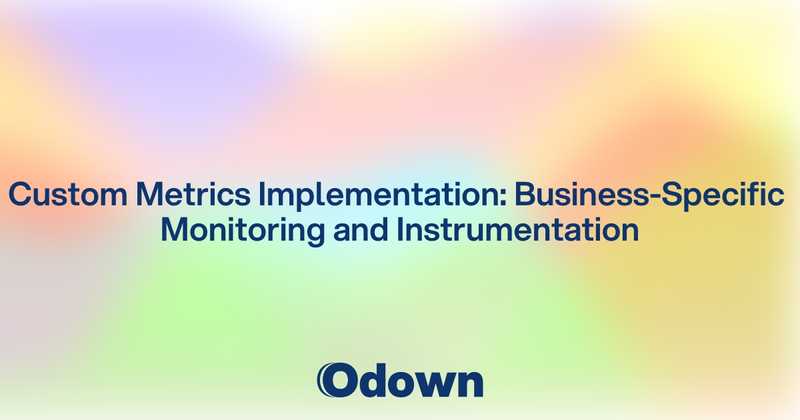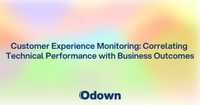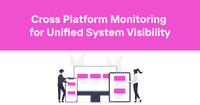Custom Metrics Implementation: Business-Specific Monitoring and Instrumentation
Your monitoring dashboard shows everything is green, but your revenue is plummeting. Your servers are running perfectly, response times look great, and error rates are low. Yet customers are abandoning their shopping carts, subscription renewals are declining, and user engagement is dropping off a cliff.
This disconnect happens because most monitoring focuses on technical metrics while ignoring the business metrics that actually matter. You can have perfect uptime and still be failing your customers in ways that standard monitoring never reveals.
Custom metrics bridge this gap by tracking the specific indicators that matter to your business. Instead of just monitoring whether your application is running, you monitor whether it's achieving its business objectives. Comprehensive monitoring platforms provide the foundation for both technical and business metric tracking.
The companies that succeed long-term don't just monitor their infrastructure---they monitor their business performance in real-time. This guide shows you how to implement custom metrics that reveal what's really happening with your business, not just your servers.
Designing Custom Metrics: KPIs That Matter to Your Business
Standard monitoring metrics like CPU usage and response time matter, but they don't tell you if your business is succeeding. Custom metrics translate business outcomes into measurable indicators that help you make better decisions.
Identifying Business-Critical Metrics
The best custom metrics directly correlate with business outcomes and provide actionable insights when something goes wrong:
Revenue-impacting metrics track activities that directly affect your bottom line. For an e-commerce site, this might include cart abandonment rates, checkout completion percentages, or average order values. For a SaaS platform, it could be trial-to-paid conversion rates or monthly recurring revenue growth.
User engagement metrics reveal how effectively your application meets user needs. Page views per session, time spent in key features, or daily active user counts provide insights into user satisfaction that technical metrics miss entirely.
Operational efficiency metrics track how well your business processes are working. Customer support ticket resolution times, onboarding completion rates, or feature adoption percentages help you optimize business operations alongside technical performance.
Metric Granularity and Segmentation
Raw numbers tell incomplete stories. The real insights come from breaking metrics down by relevant dimensions:
User segmentation reveals how different user groups experience your application. New users might have different patterns than power users, and identifying these differences helps you optimize experiences for each group.
Geographic segmentation shows how performance varies by location. Your application might work perfectly for users in your primary market but struggle in international markets due to latency or localization issues.
Time-based segmentation identifies patterns that occur at different times or during specific events. Holiday shopping patterns, end-of-month business cycles, or weekend usage differences can significantly impact your metrics.
Leading vs Lagging Indicators
The most valuable custom metrics combine leading indicators that predict problems with lagging indicators that confirm results:
Leading indicators help you catch problems before they fully manifest. A sudden drop in user registrations might predict revenue problems weeks before they show up in financial reports.
Lagging indicators confirm whether your interventions worked. Revenue and customer satisfaction scores are lagging indicators that tell you if your changes actually improved business outcomes.
Correlation analysis helps you understand the relationships between different metrics. For example, you might discover that support ticket volume correlates with specific feature releases or that user engagement drops before subscription cancellations.
Application Instrumentation: Adding Monitoring to Existing Code
Adding custom metrics to existing applications requires careful planning to avoid performance impacts while gathering meaningful data. The goal is comprehensive visibility without degrading user experience.
Strategic Instrumentation Points
Not every line of code needs instrumentation. Focus on the points where business-critical activities occur:
User journey tracking instruments the key paths users take through your application. Track when users start registration, complete onboarding, make purchases, or achieve other important milestones.
Feature usage monitoring tracks how often users engage with specific features. This information helps you prioritize development efforts and identify features that might need improvement or removal.
Error and exception tracking goes beyond simple error counts to understand the business impact of problems. A database timeout might be a technical issue, but if it prevents users from completing purchases, it becomes a business-critical problem.
Performance-Conscious Implementation
Custom metrics shouldn't slow down your application or consume excessive resources:
Asynchronous logging ensures that metric collection doesn't block user-facing operations. Queue metric data for background processing rather than making synchronous calls to monitoring systems.
Sampling strategies reduce overhead for high-volume metrics. You don't need to track every single page view, but sampling a representative subset provides useful insights without overwhelming your monitoring system.
Metric aggregation reduces the amount of data you need to store and process. Instead of storing individual transaction details, aggregate them into meaningful summaries like hourly totals or user segment averages.
Code Organization and Maintainability
Custom instrumentation code needs to be maintainable and consistent across your application:
Centralized metric libraries provide consistent interfaces for recording metrics throughout your application. This approach ensures metrics are recorded consistently and makes it easier to modify instrumentation later.
Configuration-driven instrumentation allows you to adjust metric collection without code changes. You might want to increase sampling rates during problem investigations or temporarily disable expensive metrics during high-traffic periods.
Documentation and naming conventions help team members understand what metrics measure and how to use them effectively. Clear metric names and descriptions prevent confusion and ensure metrics are used correctly.
Custom Dashboard Creation: Visualizing Business and Technical Metrics
Raw metrics are useless without proper visualization. Effective dashboards translate complex data into actionable insights that help different stakeholders make informed decisions.
Dashboard Design for Different Audiences
Different stakeholders need different views of your metrics:
Executive dashboards focus on high-level business outcomes and trends. Revenue growth, customer acquisition costs, and user satisfaction scores matter more than technical implementation details.
Operations dashboards combine business and technical metrics to help teams understand the relationship between system performance and business outcomes. Response times matter, but so do conversion rates and user engagement.
Developer dashboards emphasize technical metrics that help with troubleshooting and optimization. Error rates, performance bottlenecks, and system resource usage help developers identify and fix problems.
Effective Visualization Techniques
The right visualization makes patterns obvious while the wrong one obscures important insights:
Time series charts work well for metrics that change over time. Revenue trends, user growth, and performance metrics all benefit from time-based visualization that reveals patterns and anomalies.
Heat maps help you understand how metrics vary across different dimensions. You might use heat maps to show how user engagement varies by geographic region or how error rates change across different application features.
Correlation charts reveal relationships between different metrics. Scatter plots can show how response time affects user engagement or how marketing campaigns impact user acquisition.
Real-Time vs Historical Analysis
Different types of analysis require different data presentation approaches:
Real-time dashboards help you respond quickly to immediate problems. Current error rates, active user counts, and system health indicators need to update frequently to support rapid response.
Historical analysis dashboards help you understand trends and make strategic decisions. Monthly revenue trends, user retention cohorts, and long-term performance patterns require different visualization approaches than real-time monitoring.
Alerting integration ensures that dashboards not only display information but also trigger appropriate responses when metrics indicate problems.
Alert Optimization: Reducing Noise While Catching Critical Issues
Poorly configured alerts create alert fatigue that causes teams to ignore important warnings. Effective alert optimization ensures that alerts provide actionable information without overwhelming your team with false positives.
Alert Prioritization and Severity Levels
Not all problems deserve immediate attention. Effective alert systems distinguish between different types of issues:
Critical alerts indicate immediate threats to business operations. Complete system outages, security breaches, or payment processing failures require immediate response regardless of the time of day.
Warning alerts indicate problems that need attention but don't require immediate response. Performance degradation, increasing error rates, or approaching resource limits might need investigation during business hours.
Informational alerts provide context and help with trend analysis. Unusual but not necessarily problematic patterns might be worth noting but don't require immediate action.
Context-Aware Alerting
Alerts become more valuable when they include context that helps responders understand the situation:
Business impact context explains why an alert matters. Instead of just reporting a high error rate, explain that it's affecting the checkout process and potentially costing revenue.
Historical context helps responders understand whether current conditions are normal or unusual. An error rate that seems high might actually be typical for certain times of day or during specific events.
Remediation suggestions provide guidance on how to respond to alerts. Include links to runbooks, relevant documentation, or similar past incidents to help responders act quickly.
Dynamic Alert Thresholds
Static alert thresholds often generate false positives because they don't account for normal variation in your metrics:
Machine learning-based thresholds adapt to normal patterns in your metrics and alert when values deviate significantly from expected ranges. This approach reduces false positives while catching genuine anomalies.
Time-based thresholds account for expected variations throughout the day, week, or year. Your normal traffic patterns on Sunday night are different from Monday morning, and your alerts should reflect these differences.
Composite alerts combine multiple metrics to reduce false positives. A single metric spike might not indicate a problem, but multiple correlated metrics moving together often signals real issues.
Effective custom monitoring requires platforms that can handle both technical and business metrics seamlessly. Infrastructure as Code monitoring strategies provide the foundation for monitoring the systems that collect and process your custom metrics.
Ready to implement custom metrics that actually drive business decisions? Use Odown and build monitoring that tracks what matters most to your organization's success and growth.



